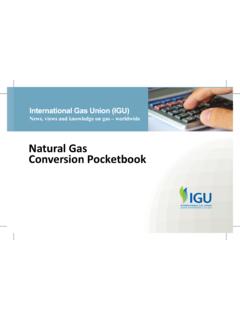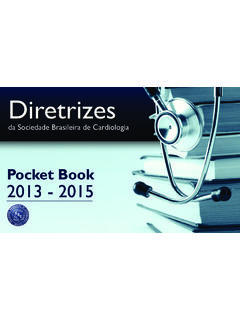Transcription of FAO Statistical Pocketbook Coffee 2015
1 Statistical Pocketbook - Coffee 2015I4985E/1 Coffee Pocketbook2015 Food and Agriculture Organization of the United Nations, Rome, 2015 The designations employed and the presentation of material in this information product do not imply the expression of any opinion whatsoever on the part of the Food and Agriculture Organization of the United Nations (FAO) concerning the legal or development status of any country, territory, city or area or of its authorities, or concerning the delimitation of its frontiers or boundaries. The mention of specific companies or products of manufacturers, whether or not these have been patented, does not imply that these have been endorsed or recommended by FAO in preference to others of a similar nature that are not mentioned.
2 The views expressed in this information product are those of the author(s) and do not necessarily reflect the views or policies of FAO. ISBN 978-92-5-108894-4 FAO, 2015 FAO encourages the use, reproduction and dissemination of material in this information product. Except where otherwise indicated, material may be copied, downloaded and printed for private study, research and teaching purposes, or for use in non-commercial products or services, provided that appropriate acknowledgement of FAO as the source and copyright holder is given and that FAO s endorsement of users views, products or services is not implied in any way. All requests for translation and adaptation rights, and for resale and other commercial use rights should be made via or addressed to FAO information products are available on the FAO website ( ) and can be purchased through ForewordToday, more people are consuming more Coffee than ever before.
3 As the middle classesof the developing world continue to swell, as their incomes rise and Coffee remainsaffordable, the luxury of the occasional Coffee has become a daily habit in an ever-growing number of countries. The rising demand has also afforded producers with newoptions and opportunities. Coffee has become an important contributor to cash incomefor many smallholders, who produce most of the world s beans. The annual output hasnow reached almost nine million tonnes, one million tonnes more than a decade gross value of production of green Coffee now exceeds US$16 billion, and its exportvalue reached US$24 billion in rising demand offers unprecedented opportunities to growers, they also have tolive up to a growing set of challenges.
4 Many are confronted with inadequate access tocredit, high price volatility, as well as bureaucratic hurdles at home and market bar-riers abroad. And, they are operating in a global value chain where a vast and oftenunorganized number of small Coffee growers are exposed to the market power of a few,large traders and roasters. In addition, many smallholders find it hard to cope with thevagaries of weather in the short-run and the deteriorating growing conditions broughtabout by climate change over the Pocketbook puts numbers to these developments, assesses short-term changesand long-term trends in production, consumption, trade and prices, and provides usefulbackground information on related shifts in poverty, health and rural development.
5 Itis part of the FAO Statistical Yearbook suite of products and is organized around twomajor sections: thematic spreads with data-driven visualizations, and comprehensivecountry and regional is strongly committed to helping countries strengthen their national Statistical sys-tems and improve the timeliness and quality of their data. This includes a commitmentto improve and broaden the information necessary to support evidence-based decisionmaking by all stakeholders in the Coffee value GennariChief Statistician and Director, ESS12 ContentsOverview6 Economy8 Poverty10 Dietary energy supply12 Coffee production14 Coffee trade16 Coffee prices18 Country Profiles22 Definitions191 Notes1943 AfricaAmericasAsiaEuropeOceaniaFIGURE 1:Classification of countries45 OverviewA combination of declining mortality rates,prolonged life expectancy and younger pop-ulations in regions with high fertility con-tributes to continuous, albeit declining pop-ulation growth in the world.
6 While ratescontinue to slow, the world s population hasnevertheless doubled since the late 1960s,to over 7 billion people today. Generally,population growth is high where income lev-els are low. This is especially true in 2008, more people live in cities thanin rural 20152050billion peopleRural populationUrban populationData after 2015 are projectionsCHART 1:Rural and urban populationTokelauNiueRepublic ofMoldovaLatviaLithuaniaN. MarianaIslandsGeorgiaBulgariaUkraineEsto niaUgandaChadRwandaEritreaLiberiaNigerKu waitBahrainUnited ArabEmiratesQatar 50510percentCountries with highest valuesCountries with lowest valuesCHART 2:Population, average annual growth(2004-2014)Sierra LeoneBotswanaSwazilandLesothoDR CongoCentral AfricanRepublicMozambiqueC te d'IvoireChadAngolaLuxembourgFranceIsrael AustraliaItalySingaporeSpainSwitzerlandI celandJapan50607080percentCountries with highest valuesCountries with lowest valuesCHART 3:Life expectancy at birth, countrieswith the highest and lowest values (2013)05001 0001 5002 000200020052010million peopleAfricaAmericasAsiaEuropeOceaniaCHA RT 4.
7 Total economically active population (2000 to 2014)6 PercentNo Data0 ~< 1515 ~< 3232 ~< 4747 ~< 6464 ~< 100 FIGURE 2:Rural population, share of total population (2014)7 EconomyChanges in the wider economy, includinggrowing global integration and there-fore trade, currency movements and inter-national prices affect the performance ofcommodities in the agricultural sector, in-cluding Coffee production. During the globaleconomic downturn of the last decade, somesectors were particularly hard hit. Agricul-ture was affected too, but the Coffee sec-tor has demonstrated remarkable 2008, the value of Coffee productionhas grown at over percent per year, whichis faster than percent overall growth 5:Value added, share of GDP (2013)New ZealandAustriaGermanyLuxembourgSingapore DenmarkLebanonSpainSwedenAustraliaJapanI talyBelgiumNetherlandsFinlandUnited Statesof AmericaNorwayIcelandFranceSlovenia40 00080 000 120 000US$CHART 6.
8 Agriculture value added per worker,countries with the highest valuesIrelandBahamasUnited ArabEmiratesMaltaZimbabweGreeceBulgariaS amoaLuxembourgNamibiaSierra LeoneLiberiaAlgeriaUzbekistanParaguayMon goliaTajikistanEthiopiaAngolaTurkmenista n01020percentCountries with highest valuesCountries with lowest valuesCHART 7:Life expectancy at birth, countrieswith the highest and lowest values (2013)51015200020052010percentAfricaAmer icasAsiaEuropeOceaniaCHART 8:Value added in agriculture as share of GDP8 PercentNo Data0 ~< 33 ~< 77 ~< 1212 ~< 2323 ~< 59 FIGURE 3:Value added in agriculture, share of GDP (percent, 2010 to 2013*)9 PovertyMost Coffee is produced in developing coun-tries. Yet the benefits from the expansion ofthe Coffee industry in recent years have notalways trickled down to the poorest.
9 Amongthe largest Coffee producing countries, manystill have more than 10 percent of their pop-ulations living below US$ a day. How-ever, change is on the way, and Coffee playsa pivotal role in this process. Coffee produc-tion and the proceeds from it have alloweda growing number of small and poor farm-ers to escape the poverty trap. By adaptingnew technologies or by switching to bettervarieties, many now harvest higher crops ofbetter quality 1:People living on less than 2005 PPP$ a day (mln)19902015*East Asia & Pacific93986 Europe & Central Asia71 Lat Amer & Caribbean5327 Mid East & N Africa137 South Asia620311 Sub-Saharan Africa290403 World1 923836* forecastSloveniaUkraineSlovakiaNorwayDen markIcelandCzech RepublicBelarusRomaniaFinlandPanamaRwand aChileGuatemalaBrazilLesothoColombiaHond urasZambiaSouth Africa40506070percentCountries with highest valuesCountries with lowest valuesCHART 9.
10 Income share held by highest 20(percent) (2010-2014)MalaysiaTurkeyKazakhstanBelar usSri LankaAzerbaijanUkraineMontenegroCzech RepublicBrazilGuineaLesothoHaitiTogoZamb iaHondurasDR CongoGuinea BissauZimbabweMadagascar0204060percentCo untries with highest valuesCountries with lowest valuesCHART 10:Poverty headcount ratio atnational poverty line (population share)0204060199019952000200520102015% of populationEast Asia & PacificEurope & Central AsiaLat Amer & CaribbeanMid East & N AfricaSouth AsiaSub Saharan AfricaWorldCHART 11:Share of population living on less than 2005 PPP $ a day (%)10 PercentNo Data0 ~< 00 ~< 44 ~< 1515 ~< 3939 ~< 88 FIGURE 4:Share of population living less than US$ per day (2007 - 2012)11 Dietary energy supplyTThe dietary energy supply (DES) is the foodavailable for human consumption, expressedin kilocalories per person per day.















![[ 家賃の支払・算定 ] - sendai-kensetsu.or.jp](/cache/preview/7/f/4/5/c/5/0/7/thumb-7f45c5072faa1529eb851daa9e2f9fe7.jpg)
